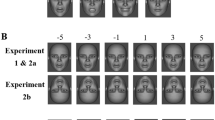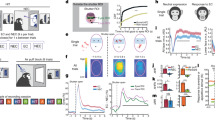Abstract
Emotions operate along the dimension of approach and aversion, and it is reasonable to assume that orienting behavior is intrinsically linked to emotionally involved processes such as preference decisions. Here we describe a gaze 'cascade effect' that was present when human observers were shown pairs of human faces and instructed to decide which face was more attractive. Their gaze was initially distributed evenly between the two stimuli, but then gradually shifted toward the face that they eventually chose. Gaze bias was significantly weaker in a face shape discrimination task. In a second series of experiments, manipulation of gaze duration, but not exposure duration alone, biased observers' preference decisions. We thus conclude that gaze is actively involved in preference formation. The gaze cascade effect was also present when participants compared abstract, unfamiliar shapes for attractiveness, suggesting that orienting and preference for objects in general are intrinsically linked in a positive feedback loop leading to the conscious choice.
This is a preview of subscription content, access via your institution
Access options
Subscribe to this journal
Receive 12 print issues and online access
$209.00 per year
only $17.42 per issue
Buy this article
- Purchase on Springer Link
- Instant access to full article PDF
Prices may be subject to local taxes which are calculated during checkout


Similar content being viewed by others
References
Leopold, D.A., O'Toole, A.J., Vetter, T. & Blanz, V. Prototype-referenced shape encoding revealed by high-level aftereffects. Nat. Neurosci. 1, 3–5 (2001).
Mandler, G., Nakamura, Y. & Van Zandt, B. J. Exp. Psychol. Learn. Mem. Cogn. 13, 646–648 (1987).
Zajonc, R.B. Attitudinal effects of mere exposure. J. Pers. Soc. Psychol. Monogr. Suppl. 9, 1–27 (1968).
Kunst-Wilson, W.R. & Zajonc, R.B. Affective discrimination of stimuli that cannot be recognized. Science 207, 557–558 (1980).
Kleinke, C.L. Gaze and eye contact: a research review. Psychol. Bull. 100, 78–100 (1986).
Emery, N.J. The eyes have it: the neuroethology, function and evolution of social gaze. Neurosci. Biobehav. Rev. 24, 581–604 (2000).
Fantz, R.L. The origin of form perception. Sci. Am. 204, 66–72 (1961).
Birch, E.E., Shimojo, S. & Held, R. Preferential looking assessment of fusion and stereopsis in infants aged 1 to 6 months. Invest. Ophthalmol. Vis. Sci. 26, 366–370 (1985).
Butterworth, G. & Jarret, N. What minds have in common is space – spatial mechanisms serving joint visual-attention in infancy. Br. J. Devel. Psychol. 9, 55–72 (1991).
VonGrunau, M. & Anston, C. The detection of gaze direction: a stare-in-the-crowd effect. Perception 24, 1297–1313 (1995).
Nakamura, K. et al. Neuroanatomical correlates of the assessment of facial attractiveness. Neuroreport 9, 753–757 (1998).
Sakai, K. & Miyashita, Y. Neural organization for the long-term memory of paired associates. Nature 354, 152–155 (1991).
Vessel, E.A. & Biederman, I. An fMRI investigation of visual preference habituation. J. Vis. 2, 492 (2002).
James, W. What is an emotion? Mind 4, 188–204 (1884).
Tomkins, S. Affect, imagery and consciousness Vol. 1: the positive effects (Springer, New York, 1962).
Schacter, S. The interaction of cognitive and physiological determinants of emotional states in Advances in Experimental Social Psychology Vol. 1 (ed., Berkowitz, L.) 49–80 (Academic Press, New York, 1964).
Zajonc, R.B. Emotion and facial efference: a theory reclaimed. Science 228, 15–21 (1985).
Laird, J.D. Self-attribution of emotion: the effects of expressive behavior on the quality of emotional experience. J. Pers. Soc. Psychol. 29, 475–486 (1974).
Patterson, M.L. A sequential functional model of nonverbal exchange. Psychol. Rev. 89, 231–249 (1982).
Acknowledgements
We thank K. Sakai for the Fourier descriptor algorithm, B. Khurana, B. Sheth, J. Bhattacharya and M. Changizi for their comments on earlier drafts, and N. Afsarmanesh for experimental assistance. This project was partly supported by the Japan Society for Promotion of Science (JSPS Grant-in-Aid for Scientific Research, (C) 14510164) and Genesis Research Institute.
Author information
Authors and Affiliations
Corresponding author
Ethics declarations
Competing interests
The authors declare no competing financial interests.
Supplementary information
Supplementary Fig. 1.
Block diagram of our dual contribution model. The two inputs, I1 and I2, are integrated in the decision module and compared with a "consciousness threshold" T; when T is reached the decision is made. Feedback from the decision module into the structures from which the inputs originate enhances their respective signals. When the task involves attractiveness, the feedback becomes positive, through the interaction between exposure and preferential looking. It is this positive feedback loop that makes the critical difference in gaze between preference and other tasks. The dashed feedback line into the cognitive assessment systems illustrates the general belief that cognitive representations flexible yet stable, thus cannot be changed easily by short-term exposure. (PDF 5 kb)
Rights and permissions
About this article
Cite this article
Shimojo, S., Simion, C., Shimojo, E. et al. Gaze bias both reflects and influences preference. Nat Neurosci 6, 1317–1322 (2003). https://doi.org/10.1038/nn1150
Received:
Accepted:
Published:
Issue Date:
DOI: https://doi.org/10.1038/nn1150
This article is cited by
-
The role of confidence in the gaze bias effect among economics trainee teachers — results from a digital assessment of economic content knowledge
Empirical Research in Vocational Education and Training (2024)
-
Similar Gap-Overlap Profiles in Children with Fragile X Syndrome and IQ-Matched Autism
Journal of Autism and Developmental Disorders (2024)
-
Monetary incentives and eye movements: an eye-tracking investigation in a risky choice experiment with real and hypothetical incentives
Behaviormetrika (2024)
-
The cognitive reality of morphomes. Evidence from Italian
Morphology (2024)
-
Modeling Eye Movements During Decision Making: A Review
Psychometrika (2023)



